Text
Rob Pruitt, a snow white free for all.
Contemporary artists that involve drug taking within their work are usually the ones we see taking the drugs. Perhaps for the reason of unlocking a creative process or simply to experience something unnatural happen to their body. But Rob Pruitt changed this idea in 1988 with his piece, Cocaine Buffet.

Rob Pruitt is known for using humour within his works, quite a few of his works have caused outrage of being deemed too insulting to the artworld. His works have been deemed as quite controversial. Although, he challenges this with his methods and techniques of defining what exactly contemporary art can be.
Cocaine Buffet Grand Prix is a 16 foot curving mirror imitating a toy racing car track which lies on the floor with a cocaine line stretched across the entire mirror. You would think 16 feet of cocaine probably isnt cheap but Pruitt bought the drug and invited his viewers to get down and sniff the cocaine, if they are happy to be photographed doing so.
Pruitt was asked in an interview with Artspace in July 2020, “Humor plays a huge part in your art which is relatively unusual. Why? “ He responded to the question ,”This may sound like an oversimplification, but I’m really drawn to art that causes some kind of physiological change in the viewer. Most obviously the cocaine work — after ingesting the cocaine, that was the sculpture, the viewer’s perception of the work was most definitely affected.” (Artspace, 2020)
To see more of this interview, click below.
https://www.artspace.com/magazine/interviews_features/meet_the_artist/interview-rob-pruitt-on-his-new-artspace-and-public-art-fund-limited-edition-print-stronger-56606
This points out that he wanted to change the perception of the viewer when they saw the artwork through the drug.
Pruitt was asked by the observer in an interview how long it took the cocaine line to be sniffed by its visitors.
He replied that “Nothing was spoken about it. It was just simply there in the center of the space,” he said. People “didn’t know if it was baby powder or sugar or the real thing. The trepidation lasted for about an hour. Then, somebody fell to their knees. Then there were three brave souls. They broke the ice. … And then it just became like a free-for-all.” The cocaine “only lasted for about 10 more minutes,” the artist said.
However, as you can imagine this artwork caused quite the scandal when it was on display and caused great controversy by art critics. Perhaps, you might think this type of performance has to be illegal and it probably was but that's never stopped Pruitt before.
It could not only portray the changing of traditional art methods but also questions the exact meaning of the piece. Is it a peace offering? A minimalist performance artwork? A portrayal of greed? Is it just simply to cause controversy and grab people's attention? Or maybe bring a group of people with a similar interest together, however, with the use of contemporary art like this, there should be a million questions about what it exactly means. In my opinion I think the mystery behind it is what gives the artwork its originality and exhilaration.
Shown below is just a few images and a link of the snow white free for all.
http://www.robpruitt.com/1990

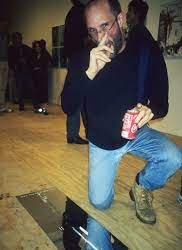
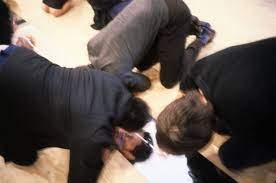

2 notes
·
View notes
Text
Marina Abramovic, the test of consciousness.
Performance art has always been an attention grabbing artform. The uniqueness and curiosity of what it might be has always been an interest of mine.
However, the performance that got my attention was Marina Abramović's Rhythm 2.
Between 1973 and 1974, Marina Abramović performed five pieces. These performances included the artist testing the limitations of her body and mind. Abramovic’s performances challenge the traditional use of what art mediums can be by using her own body as her canvas.
The reason Rhythm 2 stood out to me however was the length the artist was willing to go to in order to get her message across. This performance contained a two parts in which the artist would sacrifice her body and thoughts, while still having a functioning mind. Exploring the link between her body and her mind is always an active theme throughout most of Abramovic’s work. However, executing an art performance this drastic, using her body as the medium while also losing control over it was not a performance visitors wanted to miss.
This performance consisted of going to extreme measures to test her consciousness while remaining lucid. The artist was still going to be able to be aware of what was happening to her body, which is definitely the aspect of the performance that grabbed my attention.
She performed this work in Zagreb at the Gallery of Contemporary Art. She designed the performance as two parts that were spread across seven hours to separate the medications she was planning to take.
The first part involved her consuming a type of medication used for patients that suffer from catatonia. Catatonia patients mainly suffer from extreme motor immobility. The specific medication for this is used to help the patients change how their bodies are laid out, forcefully making the muscles shake. During the 50 minutes of this first performance, Abramovic’s muscles began violently contracting without any of her control. This made the artist’s body begin experiencing seizures and spasms. She was completely mentally conscious and lucid during this performance. although, she was still fully observing the physical effects of the medications without having control of her body.
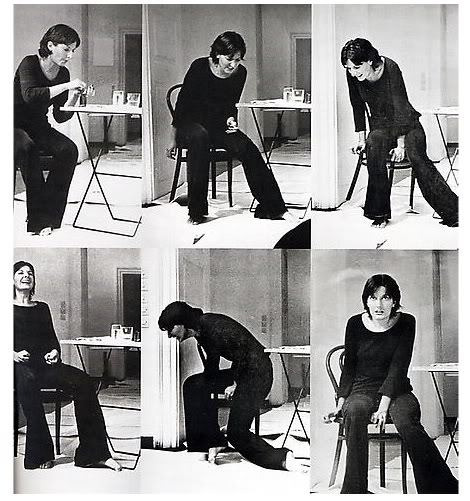
After the effects of the catatonia medication wore off the artist had a ten minute interval. After, she then began her second performance.
This involved the artist taking a different medication to the first which had complete opposite side effects of the previous medication. It is prescribed to schizophrenic patients that experience extreme aggressive episodes due to their mental illness and is used to calm them down. While the drug came into effect, the artist's control over her mind began decreasing when she finally experienced a loss of consciousness. This half of the performance lasted much longer than the previous and didn’t end until Abramovic came back into consciousness, five hours later. She explains the experience as having no memory of it at all. This part of the performance could suggest that the artist was not only sacrificing her body, but her self image. This part of the performance is what interested me the most. There's so many questions I have of what the artist did when she was absent from her mind.

In addition to this, I think Abramovic’s performances test the traditional media methods in an extreme way. The exploration of inducing the loss of your mind or body shows the extreme message she is trying to propose, which is not one to be taken lightly.
For more information on the the performance art works of Marina Abramović, you can visit a Marina Abramović Youtube channel below.
https://www.youtube.com/playlist?list=PLEb71yGj23SqdExLsq9kl82ofYhBSr9PD
6 notes
·
View notes
Text
Sous Influence, the exhibition trip of a lifetime.
Sous influence (Under influences) was a major exhibition which portrayed a variety of drug-inspired works. The individuality of this exhibition jumped out at me when doing my research for contemporary art. The exhibition was held at La Maison Rouge from February to May 2013. It holds an in depth summary of “the relationship between artists and psychotropics.”(archives.lamaisonrouge.org, 2013). To find out more however, visit the original exhibition overview.
https://archives.lamaisonrouge.org/en/exhibitions-past-detail/activities/under-influences/
Visitors that experienced the intense exhibition described it as “walking through the labyrinthine”(archives.lamaisonrouge.org, 2013) due to the experience of a trip-like journey with “the presence of acidic colors, surrealist imagery, and neon lights only provide further gateways down the rabbit hole.”(Nagesh, n.d.)
However, even though this probably seems like a fascinating exhibition showing the bright colourful creative art processes, it portrays the negative side to the using substances too. The exhibition displays this by showing the addiction side of drugs and how it can drastically affect your health. The exhibition also portrays the realistic side of taking drugs with the layout making its visitors feel as if they are coming down from a high at the end leaving them mentally exhausted.
The exhibition includes a variety of artworks in three different subjects; artworks that portray substances, artworks that show drug-users and the effects the drugs had on them and works that represent drug-induced hallucinations.
Throughout the exhibition there is many works by famous artists such as Yayoi Kusama’s Dots Obsession (Infinity Mirrored Room). This artwork is a large-scale installation depicting red balloons with white dots that float around a mirrored room inducing the viewer into a dysfunctional transient state of mind. This is one of the first rooms visitors walk into when viewing the exhibition. Viewers have often described this room as a sinister wonderland. These type of installation artworks were included within the exhibition to have a sensory “near-psychotropic effect” on the viewer. (archives.lamaisonrouge.org, 2013)
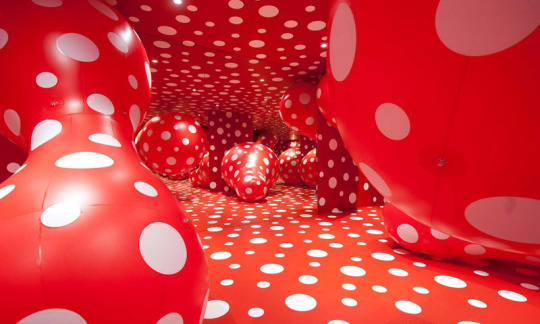
It also includes work by photographers Larry Clark and Alberto García-Alix. The documentation of disturbing photography portrays depersonalized-like drug users in their neglected housing conditions. An example of this is a photograph by García-Alix’s Gabriel which portrays a young man in front of a wall stretching with “FIX” written across. This could suggest that the man’s constant need for the drug is “fixed” within his day to day life showing the real dangers of drug-use.

Although, my favourite piece within the exhibition has to be Jeanne Susplugas, L'aspirine c’est le champagne du matin (Aspirin Is the Champagne of the Morning. The simple but effective composition perfectly shows the sarcastic comforting aesthetic of the piece. The artist describes the reason for bright neon bulbs against a simple white background as a “It’s an embodiment of calmness, the idea was to create an anti-depressant room.”(Pfeiffer and Pfeiffer, 2010) I think this was a perfect piece to include within the exhibition as it gives the viewers a mental rest from the other intense and perculiar artworks.

However, the most important aspect of the exhibition includes the “deliberately under or concomitant to the use of psychoactive substances” (archives.lamaisonrouge.org, 2013) Artists using drugs to experiment with the drugs to see how they influence their creative processes and open their mind is what the exhibition is mostly trying to portray.
(archives.lamaisonrouge.org, 2013) suggest that these artists “translating these experiences into the aesthetic realm, as presented here, will enable each individual to realise the constant complexity of their effects.”
0 notes
Text
Under the Influence, Bryan Lewis Saunders.
What interesting me most about Bryan Lewis Saunders was his determination to challenge himself. Saunders is known as a radical performance artist and poet mostly known for his spoken word rants and stand up tragedy. However, what Saunders is most known for is his daily self portraits.
On March 30 1995, Saunders began to challenge himself to draw a self portrait everyday for the rest of his life. He has stuck to his goal and so far drawn an estimated 12,400 portraits. While this sounds like a difficult enough daily challenge to keep up with, Saunders decided to begin an even more radical project to experiment with how he sees himself in 2000.
Saunders set himself the task of creating the portraits while under the influence of different recreational and prescribed drugs which he titled “Under the Influence".
These drugs ranged from alcohol to heroin to xanax to psilocybin mushrooms. He set himself the task of experimenting with these drugs to see how they altered his self image. He consumed a different drug everyday for many weeks.
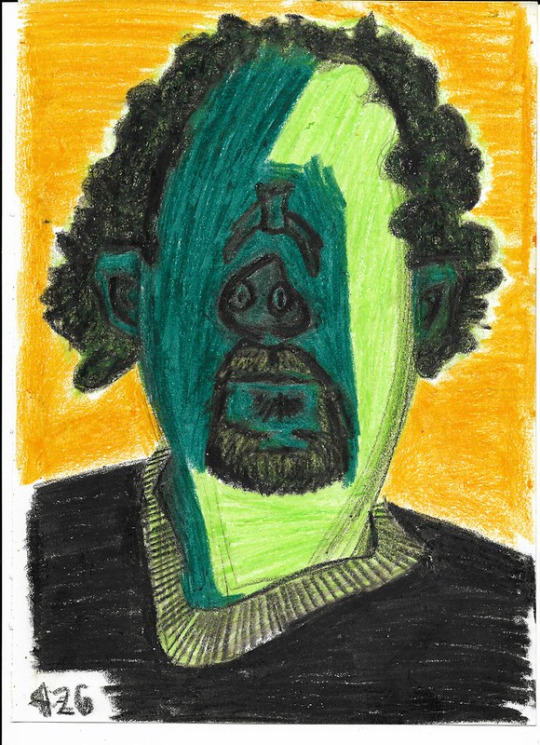
Consequently because of this, Saunders suffered brain damage (which was thankfully reversible) and was completely drained physically so as a result of this, he now only continues with the drug-induced self altering project over longer periods of time and uses the drugs only with the advice of his doctor.
Saunders portraits are a prime example of how drugs change how we see ourselves. We see this especially with the difference between his hash portrait and his pcp portrait. They portray how easily our observance of ourselves can be changed while we are intoxicated.


Furthermore, what was most interesting for me to see was the difference in how his self perception was altered rather than his self image. The aesthetic qualities within the portraits changed with the use of psychedelics. This is shown mostly within his LSD portrait.

The bright colours and exaggerated composition show how the emotion is also depicted as well as his self image.His emotions within the compositions of different portraits differ varying on the type of drug such as the cocaine portrait seems aggressive and loud whereas the marijuana portrait seems relaxed and joyful. His other portraits such as his Klonopin portrait include just a simple crayon drawing where as his opium portrait’s composition is much more complex with its shading and the use of hidden images within his face.
Saunders has been offered multiple opportunities to show his self-portraits at various galleries around the world but due to an exhibition of his being stolen, he is now quite cautious of galleries over fear of losing his work. Although, he has displayed his collection of drug-influenced self-portraits in the La Maison Rouge in Paris.
Click on the link below to the collection of the peculiar, terrifying and entrancing self portraits of Bryan Lewis Saunders.
http://www.bryanlewissaunders.org/drugs/
0 notes
Text
Bruno Botella, hallucinogenic metamorphosis.
What interested me most about Bruno Botella was his experimental works. While he is focused mostly around sculpture, he is known mostly for manipulating his mediums, reinventing the traditional sculpture methods within contemporary art, which are often referred to as controversial.

His work has been shown in numerous exhibitions at some of the key museums around the world such as Villeurbanne and the Palais de Tokyo. The experimental works of Botella could arguably be compared to overthrow “cinematic devices that have been subverted, truncated, often even literally absent. For example, he defines a cartoon as “a drawing without paper as much as it is a film without a camera.”

During the exhibition “Oborot” (held at the Palais de Toyko) in 2012, an artwork of Botella’s called Qotrob was shown.

During this artwork, he showed a plaster imprint of mould. He then infused a psychedelic substance with hallucinogenic properties, with which included green clay that came from a bag of clay which had been rejected. This infusion of this clay transformed the work.
This meant that when the artwork was handled from then on, the molecules once they were absorbed into the skin, would induce a trance-like state. After the artist was done infusing the artwork, the molecules were absorbed into his skin and began to take effect on the artist. The message behind the artwork was that the medium produced the hallucinations ``which his hands pursued” (Palais de Tokyo EN, 2016) rather than the drug therefore, invoking the reflection on the artwork. It also channelled the manipulated state of consciousness that the sculpture had put him in. As a result of this, whenever anyone tried to reshape the clay, they too would be infused with the hallucinogenic properties making the artwork untouchable.
Botella then continued to produce more sculpture changing performances of manipulating everyday products. This included an anaethsing paste for amputee patients.
Most of Botella's works rely on blindness and have a brief appearance. Throughout the artists works obscured vision is essential. He relies on the striking physicality to portray his message of metamorphosis which is essential within his work. A prime example of this Rat ce necta. This artwork was created when he transformed a painting into sculpture by filling a round silicone sheet which he had rolled into a cone with paste and then cutting the cone into slices that appear marble-like. This represents what appears to be like a MRI brain map.

He also created an anagram with the name Maillon de repli, which transformed into Doliprane Mille. This is a brand name for paracetamol, which suggests the “transformation of headache pills into archaeological curiosities.”
Throughout these artworks, Bruno Botella represents the characterization of rejecting traditional methods. The transformation of these sculptors with his most famous work involving a psychedelic drug which infuses anyone into a hallucinogenic state when touched perfectly, displays his metamorphosis-like message that he is trying to portray. Botella’s works represent that all aspects of the art world that are deemed traditional will eventually transform into a new and exciting way of art.
0 notes
Text
Opium's influence on Picasso's early period.
Picasso is one of the most influential artists of the 20th century. He is mostly known for co-founding the cubist movement. He was introduced to many new experiments to broaden his creativity during his rise to fame in the epicentre of the golden age, one of these experiments to explore his creative processes was opium.
When discussing his rose period (1904-1906), the artist used to refer to his times in the studio with his friends, passing around the bamboo opium filled pipe. He discusses using opium to get out of his creative blocks. The acid aroma that filled the room was once referred by Picasso as “the most intelligent of all odors”. (Blum and Blum, 2007)
This opium circle led to Picasso’s interest in African sculpture which was the inspiration for his traditional African masks, a frequent theme that the Spanish artist famously included in his work.

Picasso quickly became an aficionado during this time, he began smoking opium several times a week between 1904 and 1908, using it as a creative tool. It could be argued that the influence of the opium narcotic is noticeable within paintings during Picasso’s Rose Period.
During this period, his vision most likely would have been affected by the use of these drugs (opium and hash) which altered his mindset and moods. Therefore, this most likely had affected things like his artistic perception and thought process, as well as things such as mood swings and his overall mindset.
We can see the influence of opium in The Family of Saltimbanques in the figures' weary faces that have little to no expressions, the faces and body language of the figures can be seen as dreary and almost hypnotic.

The artist's drug induced perception of his artworks can also be seen in Acrobat and Young Harlequin with the blank faces and blue and rose colour palette. A palette most used during this artistic period which shows Picasso’s opi-narcotic artistic view on his paintings. Picasso painted The Family of the Saltimbanques in a poorly lit room with his often drug induced friends viewing it from the side of the stage. With his intoxicated friends watching him create his work through nothing but a candlelight, this arguably could be the “creation of voyeurism – exhibitionism of a primal scene.” (Blum and Blum, 2007)
Due to the drug's side effect of feeling like time is slipping away while under the influence, the artist discovered he wanted to create a new style. One that “add the dimension of time to the spatial dimensions of painting, and to depict figures in motion from many angles simultaneously”.(Blum and Blum, 2007) With this new style and the artists narcotic epiphanies, art critics named this new geometric abstraction style, cubism. We can clearly see the combination of the artist's new unique style and the inspiration from his opium induced brain in Les demoiselles d'avignon, with the blank faces and slouch like body language of the figures.

The artist's drug induced days came to an end however in 1908 when his close friend Karl-Heinz Wiegels was found dead after a drug induced breakdown. This was due to his frequent use of opium along with other drugs such as hash, almost exactly what Picasso was smoking. After Picasso witnessed this he vowed to never touch the bamboo pipe again and went on with his life drug free. Although, the opium-like features and ideas are arguably an often recurring theme in the rest of his works he created later in life.
#pablopicasso#Les demoiselles d'avignon#The Family of Saltimbanques#cubsim#roseperiod#contemporaryart
3 notes
·
View notes
Text
This generation's most important psychedelic contemporary artist.
Alex Grey is an American visionary artist, author and Vajrayana practitioner. His oeuvre varies from a range of forms such as performance art, sculpture, visionary art, and painting. He refers to his contemporary psychedelic culture as “my art has always been in response to visions. Rather than confine myself to representations of the outer worlds, I include portrayals of multi-dimensional imaginal realms that pull us towards consciousness evolution.” (Oroc, 2014)
Within some of the first works I found by Alex Grey, I could can see his experience in being a medical illustrator and his passion for psychedelic art through his technique of blending the physical realms of the human body. What interested me most about his work though was the auras and physically energy fields surrounding the body in his paintings. Most of his work depicts a human body stripped of its skin showing the organs, bones, veins etc. as a complex system in a variety of bright colours.

Although, to understand Grey’s fascinating explanation of his first DMT experience, you would need to watch the interview. https://www.youtube.com/watch?v=wPsNAJVS-E8
In this interview with DMT: The spirit molecule he explains how his first time using DMT (N,N-Dimethyltryptamine) became a reference point for his work. DMT is a hallucinogenic tryptamine drug. It produces effects similar to psychedelics, like LSD and magic mushrooms. When people partake with the drug, the concept of the divine visions become clear when identifying experimental contexts (e.g., the recreational use of tryptamines).The influence of the drug alters the understandings of consciousness, which is a clear focal point within Grey’s work.
The most interesting aspect of Grey’s history with the drug for me was when he spoke about how when he took his first dose of DMT. The psychedelic made him Grey hallucinate that his body was similar to the body in a painting that he had dreamt about the week before. After this experience he created a piece that represented what he saw during the trip and titled it, Collective Vision.

Throughout Alex Grey’s work, he includes many religious symbols such as geometrical shapes, multicultural situations, auras and chakras. He quickly gained an audience when the psychedelic community discovered his art and realised his work contained “many miraculous snap shots of the psychedelic realm, faithfully rendered vistas that were brought back with great skill from the far shores of the visionary experience.”
Alex's mind/body/spirit experiences eventually lead to his exemplary "Sacred Mirrors" series which were 21 vibrant life-sized paintings that portrayed the interplay between the body's physical and spiritual anatomy. This is my favourite art piece by the artist as I think it gives an out of body experience for the viewers. To see more of the life sized paintings, I would recommend the link below. https://www.alexgrey.com/art/paintings/sacred-mirrors/

Alex Grey’s influence on psychedelic culture has been a one of a kind. The use of his artwork on the album covers of bands like Tool for their album 10,000 days. Alex speaks about how he couldn't pick a certain idea for the album cover and just showed the band member Alex, a painting that he was working on in the studio called the Net of Being.

This involvement gained him a lot of attention with youth culture.
Although, the involvement of his artwork in The Burning Man structure in 2006 is what I think is the main motive for his status as this generation’s most important psychedelic artist.
1 note
·
View note